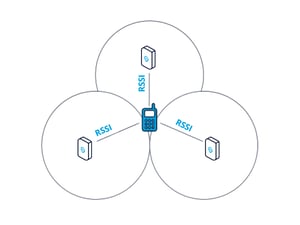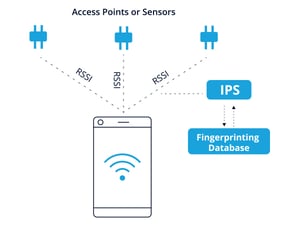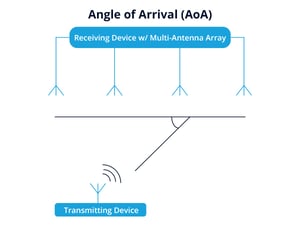Learn more about Wi-Fi and how this omnipresent radio-frequency technology can be used to detect location and be easily activated to power a multitude of indoor positioning and location-based IoT applications.
Wi-Fi is a radio-frequency technology for wireless communication that can be leveraged to detect and track the location of people, devices and assets, and can be easily activated for indoor positioning with existing Wi-Fi access points (APs) and hotspots. Incredibly vital and widespread, the Wi-Fi ecosystem is ubiquitous all throughout our daily lives. Wi-Fi is everywhere, especially in our indoor spaces, used by nearly all wireless devices and network infrastructures - including smartphones, computers, IoT devices, routers, APs, and more. Like other communication protocols including BLE and UWB, Wi-Fi can be used to transmit data between devices using radio waves.

To this day, Wi-Fi is still an effective option for indoor positioning, although it is typically less accurate than competing positioning technologies like BLE and UWB. Wi-Fi’s continued significance as a key technology for location-based applications, is largely in part because of the large number of Wi-Fi devices and already established Wi-Fi infrastructures throughout indoor spaces.
The recent release of the next generation of Wi-Fi, Wi-Fi 7, will further strengthen Wi-Fi’s role as one of the world’s most important technologies. Wi-Fi 7 is designed to be significantly quicker, more reliable, accurate, and secure than previous generations. It’s built for the new IoT landscape and will lead to more Wi-Fi devices that have cutting-edge capabilities for transformative use cases, many of which will draw on location.
Wi-Fi’s vast presence and accessibility makes it a very important standard for indoor positioning applications. It can be leveraged in many location-based use cases and offers options to easily get started with indoor positioning through existing Wi-Fi infrastructures.
Wi-Fi indoor positioning solutions use existing Wi-Fi access points or Wi-Fi enabled sensors, to detect and locate transmitting Wi-Fi devices, such as smartphones and tracking tags throughout indoor spaces. Location data collected by sensors or access points, or sent from APs to client devices, is ingested by various locationing applications and translated into insights that power multiple location-aware use cases. Wi-Fi-based positioning systems can use different methods to determine the location of devices. Most rely on Received Signal Strength Indicator (RSSI) based techniques. However, some applications can leverage more advanced Wi-Fi positioning methods.
Wi-Fi positioning with access points relies on the existing Wi-Fi infrastructures installed throughout indoor spaces to locate devices. This allows organizations to leverage their existing infrastructure to enable location-aware applications, with no additional hardware required. Building APs can detect transmissions from surrounding Wi-Fi devices, both on and off network. This location data is then sent to a server and central IPS and used to calculate a device’s position.
Wi-Fi positioning with sensors utilizes Wi-Fi-enabled sensors that are deployed in fixed positions throughout an indoor space. These sensors passively detect and locate transmissions from smartphones, asset tracking tags, beacons, personnel badges, wearables and other Wi-Fi devices. The location data collected by the sensor is then sent to a server and ingested by the central indoor positioning system (IPS) or real-time location system (RTLS). The location engine analyzes the data to determine the location of the transmitting device. Those coordinates can be used to visualize the location of a device or asset on an indoor map of your space or leveraged for other uses depending on the specific location-aware application.
The most commonly used Wi-Fi positioning techniques determine location by using a measure called received signal strength indicator (RSSI), primarily for device multilateration or fingerprinting calculations. These signal strength-based approaches are easy to implement and cost-effective, but don't achieve high degrees of accuracy since signal strength can be influenced by the surrounding environment. RSSI solutions are also susceptible to errors introduced by objects moving within the environment, particularly people. The addition of other less common, more cutting-edge techniques can lead to more accurate Wi-Fi positioning results including Angle of Arrival (AoA) and Time of Flight (ToF).

In RSSI-based applications, multiple existing Wi-Fi access points or Wi-Fi enabled sensors deployed in a fixed position will detect transmitting Wi-Fi devices and the received signal strength of the signal from the device. This location data collected by APs or sensors is sent to the central indoor positioning (IPS) or real-time location system (RTLS). The location engine analyzes the data and uses multilateration algorithms to estimate the location of transmitting devices. Alternatively, the signal strength of nearby APs relative to a wireless device can be used to determine the device’s location.
Using an RSSI-based method with multilateration is the most easily activated and low-cost option for Wi-Fi positioning. However, it doesn't deliver a high degree of positional accuracy because it is subject to signal attenuation, absorption, reflection and interference.

Fingerprinting is also a RSSI-based method. Wi-Fi positioning via fingerprinting involves using a database which records the location and signal strengths of surrounding APs , as well the coordinates of a Wi-Fi device, such as a smartphone or tracking tag in an inactive phase. To create the fingerprinting database, a time-consuming calibration process is necessary which may need to be repeatedly performed. While actively tracking a device, the RSSI values are compared to these fingerprints in the database to estimate the prior trained device’s location.
Like determining location via signal strength and multilateration, fingerprinting doesn’t deliver a high degree of positional accuracy, unless the system is continuously calibrated to reflect environmental changes. It is a low-cost method for Wi-Fi positioning, but requires continuous updating to the trained RF-patterns in the database. Fingerprinting approaches are also affected by signal attenuation (most influence), absorption, reflection and interference.
ToF is a highly accurate indoor positioning method, used by precision technologies like UWB. This advanced technique can precisely measure distance between Wi-Fi devices by calculating the time it takes for signals to travel between devices.
ToF can be leveraged to detect the precise location of a Wi-Fi device using multiple sensors or access points. This requires a dense deployment of APs or sensors to detect a Wi-Fi device, such as a smartphone or tracking tag. To work properly, the sensors or APs need to be accurately synchronized to the same master clock. The signals of the Wi-Fi device will be received by the APs or sensors in the communication range and time-stamped. All the time-stamped data is then sent to the central IPS or RTLS. The location engine will analyze each anchor’s data and the differences in arrival times to each anchor and use multilateration to accurately calculate the tag’s coordinates.
While ToF enables more accurate Wi-Fi positioning, deploying this approach comes with a greater level of complexity, and may not be cost-effective in scenarios when high accuracy is not required. Wi-Fi Round-Trip-Time (Wi-Fi RTT) is an emerging method to determine the location of Wi-Fi devices that uses ToF. Specified in the IEEE 802.11-2016 standard, Wi-Fi RTT enables devices to measure the distance between devices with the round trip time it takes for a signal to travel between the devices. This calculation is based on the path traveled by the signal and determined using the transmission speed of the electromagnetic wave and the speed of light. This can be used for ranging between two devices or for indoor positioning using multiple APs or sensors with multilateration.

AoA is an advanced method which can deliver Wi-Fi positioning with enhanced accuracy compared to more traditional techniques like fingerprinting and RSSI. This is possible due to Multiple Input Multiple Output (MIMO) Wi-Fi interfaces. To be able to find direction, a mobile asset, such as a tag or beacon, with a single antenna transmits to a fixed Wi-Fi sensor with a multi-antenna array. The phase shift of the multiple antennas, as a result of receiving the signal, is measured and calculated to determine the angle of the transmitting mobile device and create an area of certainty of the object to be located.
One advantage of an AoA approach is that it reduces the number of necessary reference points. Instead of a minimum of three sensors as required for any multilateration approach, you only need two to create an unambiguous determination of position. Additional reference points add to the accuracy and reliability of the calculated positions. While indoor positioning via AoA is more accurate than signal strength approaches, solutions that leverage this technique are only just entering the market.
Wi-Fi 5 and lower is typically less accurate than other RF technologies, such as UWB and BLE, and achieves location accuracy typically under 10 meters (with optimal conditions and deployment). The current standard Wi-Fi 6 promises accuracy in the meter range, but as it is new technology, this has yet to be shown in the field. A future update to the standard expected in March 2021, 802.11az also termed Next Generation Positioning (NGP) promises improved location accuracy.
When using APs alone, the positional accuracy is much lower, however, Wi-Fi enabled sensors can be added to augment traditional APs tracking or even as standalone sensors for more accurate indoor positioning. Different Wi-Fi positioning methods can also yield different degrees of accuracy. Traditional approaches like RSSI multilateration and fingerprinting deliver accuracy far below more advanced methods like AoA, ToF, and Wi-Fi RTT.
The range of Wi-Fi positioning can differ depending on factors such as whether you are using Wi-Fi APs or sensors or the nature of the indoor space. Wi-Fi operating at 2.4 GHz generally performs at a range up to 100 meters (with optimal conditions and deployment), and can even be used in outdoor environments where adequate infrastructure is in place. However, Wi-Fi operating at 5 GHz reduces range due to the higher frequency, performing at roughly 50% of the achievable 2.4GHz ranges. Plus at 5 GHz higher signal attenuation is to be expected if signals have to be sent through environmental obstacles like doors, walls or metallized windows.
Wi-Fi, like other RF standards, offers unique characteristics and advantages that may make it a suitable option, depending on individual needs, budget, facility, and specific location-based use cases. The most critical differences between Wi-Fi and other technologies, is its ability to leverage existing Wi-Fi infrastructure and flexibility to be used in many location-aware applications. Wi-Fi is present in devices all throughout indoor spaces, leveraged by many location tracking systems, and can be extended for indoor positioning across a whole suite of industries and use cases.
BLE and Wi-Fi are two of the most ubiquitous RF technologies - present all throughout our daily lives and indoor spaces. They have many similar characteristics, including operating at the 2.4GHz frequency range, large ecosystems, and established use for indoor positioning. BLE and Wi-Fi most primarily use RSSI to detect the location of people, devices, and assets, however, BLE is known to achieve a higher degree of location accuracy. BLE requires significantly less power, allowing for more flexible hardware options and applications. However, many organizations have existing Wi-Fi infrastructure that can be used for indoor positioning, while adoption of BLE likely requires the integration of new beacons, sensors, and more. Wi-Fi can communicate over longer ranges and higher data rates, both areas where BLE is much more limited.
Wi-Fi’s vast presence in our devices and indoor spaces, have made it a key RF technology for indoor location with a rather low market entry barrier. In advanced location-based scenarios, Wi-Fi can be limited due to it’s low accuracy. UWB excels in these more advanced applications where a high degree of accuracy is required. Wi-Fi’s accuracy is far less than UWB because it typically measures location not by distance, but rather signal strength, just as Bluetooth. It is also more likely to experience signal interference, to which UWB has strong immunity. UWB also requires less power, allowing for more useful and affordable tools, such as asset tracking tags that can be powered by long-lasting coin cell batteries. However, the wide array of Wi-Fi enabled devices and the ability to leverage existing infrastructure, such as Access Points, make it a significant indoor positioning technology, especially when a high degree of accuracy is not required.
* with optimal conditions and deployment
Leverage Existing Infrastructure
Wi-Fi gives organizations the ability to activate indoor positioning and localization with existing Wi-Fi infrastructure and no additional hardware.
Omnipresence
The wide availability and presence of Wi-Fi devices, allow for indoor positioning that draws on BYOD.
Scale Easily
Easily add specialized Wi-Fi sensors to strengthen and scale indoor positioning, depending on the coverage and precision you require.
Wi-Fi’s ubiquity and ability to be easily activated makes it an effective option for a large amount of indoor positioning use cases. Here are some use cases and applications where Wi-Fi indoor positioning is leveraged.
What’s Next for Wi-Fi? |
Wi-Fi 6 will lead to innovation with Wi-Fi technology all across the board. Some of the benefits of Wi-Fi 6 technology include:
Some of these advantages could lead to more accurate, quick, and reliable Wi-Fi positioning tools. More advanced techniques, such as AoA, ToF, and Wi-Fi RTT will likely become more commonplace, enabling more accessible precision Wi-Fi positioning with solutions that are more cost effective and easy to implement. Wi-Fi’s long held status as a key indoor positioning technology will likely continue. |